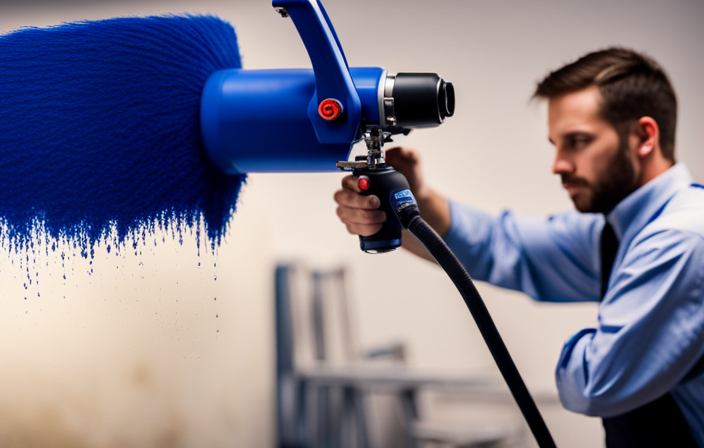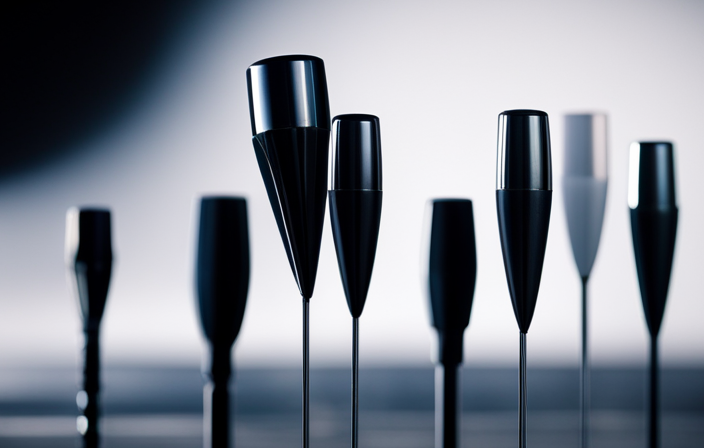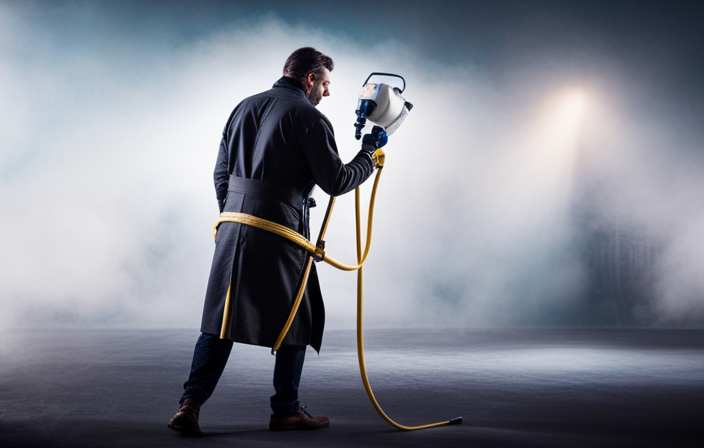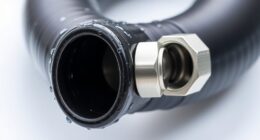It is often said that a craftsman’s best friend is a well-maintained tool. In the realm of airless paint sprayers, one crucial yet often overlooked component is the filter. As a professional painter, I understand the importance of regularly maintaining filters to achieve flawless finishes. This has motivated me to share my knowledge and expertise on the best time to replace filters in airless paint sprayers.
In this article, I will guide you through the ins and outs of filter maintenance. We’ll explore the function of filters, the signs that indicate replacement is needed, the different types of filters available, and the frequency at which they should be replaced. Additionally, I’ll provide you with valuable tips on proper cleaning and maintenance techniques, as well as the benefits of regular filter replacement.
So, whether you’re a seasoned professional or a DIY enthusiast, join me as we delve into the world of airless paint sprayer filter maintenance, and discover the key to achieving outstanding painting results every time.
Key Takeaways
- Regular filter replacement is important for achieving consistent and high-quality paint application.
- Neglecting filter replacement can lead to uneven spray patterns, paint contamination, and reduced performance.
- Using incorrect filter sizes can result in reduced paint flow, clogging, and potential damage to the equipment.
- Proper filter installation and maintenance techniques are crucial for optimal performance and longevity of the sprayer.
Importance of Regular Filter Maintenance
Regular filter maintenance is of utmost importance for optimal performance and prevention of potential issues. Proper cleaning techniques are essential to keep filters in good condition. Over time, filters can become clogged with paint particles and debris, resulting in reduced spray quality and potential damage to the paint sprayer. By regularly cleaning and replacing filters, you can extend the life of your equipment and ensure its continued optimal operation.
Some common filter problems include clogs, tears, and general wear and tear. Understanding the function of filters in airless paint sprayers is crucial for maintaining their effectiveness. Filters are designed to remove impurities from the paint, ensuring a smooth and even application.
Now, let’s move on to the next section and delve into the importance of understanding the function of filters in airless paint sprayers.
Understand the Function of Filters in Airless Paint Sprayers
Filters in airless paint sprayers play a crucial role in ensuring a smooth and even paint application by preventing debris, dirt, and contaminants from clogging the spray tip. This is important because clogged spray tips can result in uneven spray patterns and poor paint quality. To maintain optimal performance, it is essential to regularly clean the filters to prevent blockages and maintain proper paint flow. Additionally, inspecting the filters regularly helps identify any wear and tear that may affect their effectiveness. It is also important to use the right filter for the job, as different paint types require specific filters to ensure optimal performance and quality. Understanding the function of filters and how to maintain them is essential. However, there are also signs that indicate filter replacement is needed, which will be discussed in the subsequent section.
Signs that Indicate Filter Replacement is Needed
A key indication that it’s time for new filters is when the spray pattern becomes inconsistent and the paint application is no longer smooth. These are signs of clogged filters, which can occur over time as the filters become dirty and obstructed with paint particles.
To ensure optimal performance and prevent damage to your airless paint sprayer, it is important to regularly inspect and clean the filters. Best practices for filter cleaning include removing the filters from the sprayer and rinsing them with water or a cleaning solution, depending on the type of paint being used.
However, even with proper maintenance, filters will eventually need to be replaced.
In the subsequent section, we will discuss the different types of filters found in airless paint sprayers.
Types of Filters in Airless Paint Sprayers
When it comes to the types of filters in airless paint sprayers, there are three key ones to consider.
Mesh filters are used to prevent larger particles from clogging the paint sprayer, ensuring a smooth and even application.
Gun filters, on the other hand, are designed to catch any smaller particles that may have passed through the mesh filter, providing additional protection for the sprayer’s components.
Lastly, suction tube filters are responsible for filtering the paint as it is drawn into the sprayer, removing any impurities that could potentially affect the finish.
Mesh Filters
The mesh filters in airless paint sprayers need to be replaced regularly to ensure optimal performance. Cleaning mesh filters can be time-consuming and may not always remove all the built-up debris. By replacing the filters, you can guarantee that the sprayer will function at its best.
Mesh filters have several advantages. First, they effectively strain out larger particles, preventing them from clogging the spray tip. Second, they are easy to remove and clean, saving time during maintenance. Lastly, mesh filters are durable and can withstand repeated use without losing their effectiveness.
As we move on to the next section about gun filters, it is important to note that mesh filters are just one part of the overall filtration system in an airless paint sprayer.
Gun Filters
To get the best performance out of your sprayer, it’s essential to make sure your gun filters are in top shape and not as clean as a whistle. Gun filter maintenance is crucial for achieving a smooth and flawless paint application. Choosing the right filter for your airless paint sprayer is equally important. Different filters are designed to handle various materials and particle sizes, so it’s vital to select the appropriate one for your specific project. To help you make an informed decision, refer to the table below for a quick reference on gun filter options:
| Filter Type | Mesh Size | Application |
|---|---|---|
| Standard | 60 | Latex Paint |
| Fine | 100 | Stains, Enamels |
| Extra Fine | 150 | Lacquers, Varnishes |
Regularly inspecting and cleaning your gun filters will ensure optimal performance and prevent clogs. As we move on to the next section about suction tube filters, remember that maintaining all the filters in your airless paint sprayer is crucial for achieving professional and consistent results throughout your painting project.
Suction Tube Filters
Make sure your suction tube filters are clean and functioning properly for optimal performance. Cleaning the suction tube filters is an essential maintenance task for airless paint sprayers.
Over time, these filters can become clogged with debris, affecting the flow of paint and causing the sprayer to perform poorly. To clean the suction tube filters, start by removing them from the sprayer. Rinse them thoroughly with clean water to remove any paint residue or particles. If the filters are heavily clogged, you may need to use a brush or a toothpick to gently remove the buildup.
Once the filters are clean, make sure they are completely dry before reattaching them to the sprayer. Troubleshooting the suction tube filters regularly will help prevent issues and ensure smooth operation.
Now, let’s discuss the frequency of filter replacement.
Frequency of Filter Replacement
Keep in mind, you’ll be amazed at how often you’ll need to replace those filters in your airless paint sprayer. The filter lifespan can vary depending on several factors that affect filter replacement. These factors include the type of paint being used, the quality of the paint, the cleanliness of the paint container, and the amount of debris in the paint. As a general rule, it is recommended to replace the filters after every 50 gallons of paint, or whenever you notice a decrease in the spray pattern or clogging. To help you keep track of the filter replacement schedule, refer to the table below:
| Factors Affecting Filter Replacement | Filter Lifespan |
|---|---|
| Type of paint | 50 gallons |
| Quality of paint | 50 gallons |
| Cleanliness of paint container | 50 gallons |
| Amount of debris in the paint | 50 gallons |
By following these guidelines, you can ensure proper functioning of your airless paint sprayer. In the next section, we will discuss the steps to replace the filters in an airless paint sprayer.
Steps to Replace Filters in an Airless Paint Sprayer
Ready to give your airless paint sprayer a filter makeover? Let’s dive into the simple steps for refreshing those vital components!
Cleaning and replacing filters is crucial to ensure the efficiency and longevity of your airless paint sprayer.
To replace the filters, start by disconnecting the sprayer from the power source and removing the filter housing. Carefully take out the old filters and dispose of them properly.
Next, insert the new filters, making sure they fit securely in the housing. Reattach the filter housing and ensure it is tightly secured.
Finally, reconnect the sprayer to the power source and you’re ready to go! Proper cleaning and maintenance of filters is essential to maintain optimal performance.
Now, let’s explore the next section on how to effectively clean and maintain your filters.
Proper Cleaning and Maintenance of Filters
To ensure optimal performance of your airless paint sprayer, it is essential to properly clean and maintain filters. This involves using cleaning techniques that vary depending on the type of filter, such as rinsing with water or using a cleaning solvent.
Regular cleaning of filters helps remove debris and prevent clogs, which in turn ensures a smooth and even paint application. It is also important to inspect the filters for any tears or damage, as this can help identify potential issues before they become major problems.
Following the manufacturer’s guidelines for filter replacement intervals is crucial. By doing so, you can prolong the lifespan of your filters and avoid costly repairs.
In summary, by regularly cleaning and maintaining your filters, you can ensure optimal performance of your airless paint sprayer and prevent any issues from arising. Now, let’s move on to the next section and explore the benefits of regular filter replacement.
Benefits of Regular Filter Replacement
Discover the surprising benefits that come with regularly replacing your filters:
- Clean filters have a significant impact on paint quality, ensuring smooth and even application.
- Clogged filters can compromise paint spray, resulting in uneven coverage and decreased paint quality.
- Regularly replacing filters maintains optimal paint performance and achieves consistent, high-quality results.
- This saves time and money by preventing rework and enhances the longevity of your airless paint sprayer.
Don’t overlook the importance of clean filters in maximizing paint quality. Now, let’s explore some common mistakes to avoid with filter replacement.
Common Mistakes to Avoid with Filter Replacement
When it comes to filter replacement in an airless paint sprayer, there are a few common mistakes that should be avoided.
One such mistake is using incorrect filter sizes, which can lead to a decrease in performance and efficiency.
Another mistake is neglecting filter replacement altogether, which can result in clogged filters and poor spray quality.
Lastly, improper installation of filters can cause leaks and damage to the equipment.
It is important to be mindful of these mistakes and ensure proper filter replacement for optimal results.
Using Incorrect Filter Sizes
Using the wrong filter sizes in your airless paint sprayer can have disastrous results, leaving you frustrated and with a botched paint job. It’s crucial to ensure correct filter installation to avoid the consequences of using the wrong filter sizes. Here are five reasons why using incorrect filter sizes can cause problems:
- Reduced paint flow, leading to uneven coverage
- Clogging of the filter, causing frequent interruptions and time-consuming cleanups
- Increased pressure on the pump, potentially damaging the equipment
- Inefficient filtration, allowing debris and contaminants to reach the spray tip
- Premature wear and tear on the filter, leading to frequent replacement costs
Neglecting filter replacement can further compound these issues, impacting the performance and longevity of your airless paint sprayer.
Neglecting Filter Replacement
Neglecting filter replacement can have several consequences. First, clogged filters can cause uneven spray patterns and reduced paint coverage. Second, old filters may not effectively remove debris and impurities from the paint, leading to paint contamination and a poor-quality finish. To avoid these issues, regularly inspect and replace filters as recommended by the manufacturer. In the next section, we will discuss the importance of proper filter installation to enhance your painting experience even further.
Improper Installation of Filters
To avoid any potential mishaps and ensure a smooth painting experience, it is important to properly install filters. Here are four common filter installation mistakes to watch out for:
-
Incorrect orientation: Make sure to install the filters in the correct direction as indicated by the arrow on the filter. Installing them the wrong way may cause paint clogs and reduce the sprayer’s performance.
-
Loose or insecure fit: Double-check that the filters are securely fastened in place. A loose fit can result in paint leakage and uneven spray patterns.
-
Skipping the pre-filter: Don’t forget to install the pre-filter before the main filter. The pre-filter removes larger particles and debris, preventing them from clogging the main filter.
-
Ignoring filter maintenance: Installing filters is not a one-time task. Regularly inspect and clean the filters to ensure their optimal performance and longevity.
By following proper filter installation techniques, you can prevent unnecessary issues and achieve excellent painting results.
Now, let’s move on to the conclusion and final tips for filter maintenance.
Conclusion and Final Tips for Filter Maintenance
Conclusion and Final Tips for Filter Maintenance:
To maintain and prolong the performance of your airless paint sprayer, it’s important to regularly maintain and replace the filters. Here are the key tips to remember:
-
Follow the manufacturer’s instructions for filter installation and replacement to ensure proper functionality.
-
Inspect the filters before each use and clean them if necessary to remove debris or clogs that could affect spray quality.
-
Replace the filters when they show signs of wear and tear or become excessively dirty.
By following these guidelines, you can ensure that your airless paint sprayer operates at its best and consistently delivers high-quality results. Proper filter maintenance is crucial for achieving professional-grade finishes and prolonging the lifespan of your equipment.
Frequently Asked Questions
Are there any specific filters that need to be replaced more frequently than others in an airless paint sprayer?
Some specific filter types in an airless paint sprayer may require more frequent replacement than others. To ensure optimal performance, it is important to follow maintenance tips provided by the manufacturer regarding filter replacement.
Can using a dirty filter in an airless paint sprayer affect the quality of the paint job?
Using dirty filters in an airless paint sprayer can negatively impact the quality of the paint job. It is important to inspect filters regularly for damage or clogging and replace them as needed. Cleaning methods may vary depending on compatibility with specific paint types.
How often should the filters be inspected for any signs of damage or clogging?
I inspect the filters in my airless paint sprayer regularly for signs of damage or clogging. This helps me determine when to replace them. It is important to maintain the filters to ensure optimal paint quality and performance.
Are there any alternative methods to clean the filters if they cannot be replaced immediately?
If the filters cannot be replaced immediately, there are alternative cleaning methods that can help prolong their lifespan. These methods can effectively remove dirt and debris, ensuring the filters continue to function efficiently.
Can using a filter that is not recommended for the specific paint being used cause any issues with the airless paint sprayer?
Using incompatible filters in an airless paint sprayer can cause issues, such as clogging or reduced spray quality. Replacing filters regularly is essential for maintaining performance and quality of the paint job.
Conclusion
In conclusion, maintaining and replacing filters in an airless paint sprayer is crucial for optimal performance. By understanding the function of filters and recognizing the signs of replacement, you can ensure that your sprayer operates efficiently.
Regularly cleaning and replacing filters will prevent clogs and ensure a smooth paint application. Remember, procrastination is the enemy when it comes to filter maintenance. So, don’t delay, keep your filters clean and your paint sprayer in top-notch condition.
Happy painting!










